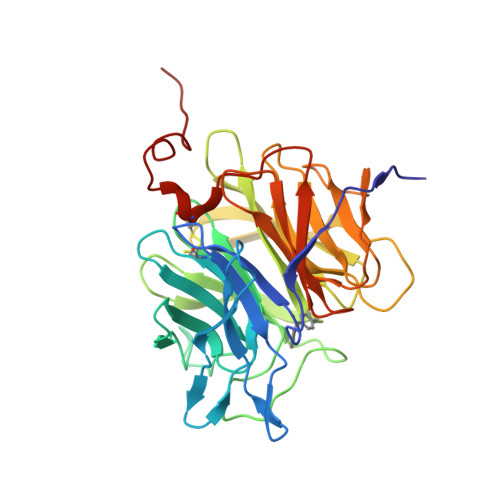A designed photoenzyme for enantioselective [2+2] cycloadditions.
Trimble, J.S., Crawshaw, R., Hardy, F.J., Levy, C.W., Brown, M.J.B., Fuerst, D.E., Heyes, D.J., Obexer, R., Green, A.P.(2022) Nature 611: 709-714
- PubMed: 36130727
- DOI: https://doi.org/10.1038/s41586-022-05335-3
- Primary Citation of Related Structures:
7ZP5, 7ZP6, 7ZP7 - PubMed Abstract:
The ability to program new modes of catalysis into proteins would allow the development of enzyme families with functions beyond those found in nature. To this end, genetic code expansion methodology holds particular promise, as it allows the site-selective introduction of new functional elements into proteins as noncanonical amino acid side chains 1-4 . Here we exploit an expanded genetic code to develop a photoenzyme that operates by means of triplet energy transfer (EnT) catalysis, a versatile mode of reactivity in organic synthesis that is not accessible to biocatalysis at present 5-12 . Installation of a genetically encoded photosensitizer into the beta-propeller scaffold of DA_20_00 (ref. 13 ) converts a de novo Diels-Alderase into a photoenzyme for [2+2] cycloadditions (EnT1.0). Subsequent development and implementation of a platform for photoenzyme evolution afforded an efficient and enantioselective enzyme (EnT1.3, up to 99% enantiomeric excess (e.e.)) that can promote intramolecular and bimolecular cycloadditions, including transformations that have proved challenging to achieve selectively with small-molecule catalysts. EnT1.3 performs >300 turnovers and, in contrast to small-molecule photocatalysts, can operate effectively under aerobic conditions and at ambient temperatures. An X-ray crystal structure of an EnT1.3-product complex shows how multiple functional components work in synergy to promote efficient and selective photocatalysis. This study opens up a wealth of new excited-state chemistry in protein active sites and establishes the framework for developing a new generation of enantioselective photocatalysts.
- Department of Chemistry, The University of Manchester, Manchester, UK.
Organizational Affiliation:

















